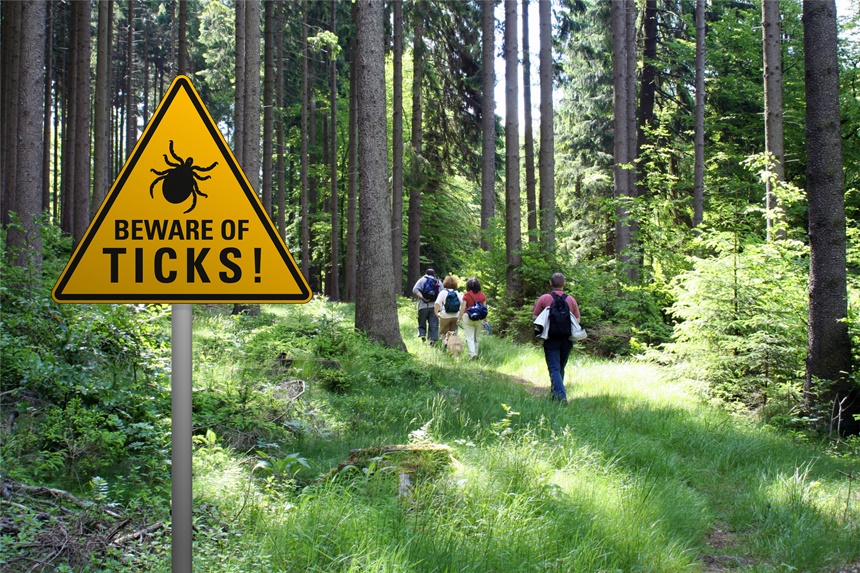“Your Health Checkup” is our online column by Dr. Douglas Zipes, an internationally acclaimed cardiologist, professor, author, inventor, and authority on pacing and electrophysiology. Dr. Zipes is also a contributor to The Saturday Evening Post print magazine. Subscribe to receive thoughtful articles, new fiction, health and wellness advice, and gems from our archive.
Order Dr. Zipes’ books, Ari’s Spoon, a new novel, as well as Bear’s Promise and Damn the Naysayers, A Doctor’s Memoir. Check out his website at dougzipes.com.
I wrote about ticks and some of the diseases they cause five years ago. As we head into summer with inevitable increased outdoor exposure from hiking, gardening, biking, and camping, I thought a reminder on tick bite prevention and treatment would be appropriate, especially since recent information indicates that tick-borne diseases have more than doubled in the U.S. in the last 20 years.
Ticks are responsible for a constellation of infections with exotic names such as babesiosis, ehrlichiosis, anaplasmosis, and more common Lyme disease and spotted fever. Spread throughout the U.S., with hotspots in the Northeast and upper Midwest, these tiny, spider-like arthropods latch on to humans and animals for a blood meal and transmit agents causing at least 16 diseases due to increases in their two most common hosts: deer and rodents. Milder winters from climate change add to the tick epidemic.
Ticks have evolved a fearsome array of weapons, including stealth; a gluey cement that anchors them to the skin; chemicals in its saliva to silence pain and itch, while destroying tissue; an anticoagulant to keep host blood flowing; and chemicals to silence the host’s immune response.
Here are some of the more common diseases spread by ticks:
Lyme disease caused by the bacterium Borrelia burgdorferi is the most well-known tick-borne illness, mostly transmitted by the blacklegged tick. The sickness often starts with a bull’s eye rash, fever, fatigue, joint pain, and headaches. Untreated, the infection can evolve to chronic arthritis, heart, and neurologic complications.
Rocky Mountain spotted fever is caused by the bacterium Rickettsia rickettsii, which is mostly transmitted by the American dog tick and Rocky Mountain wood tick. Symptoms include fever, headache, rash, muscle aches, and nausea but can progress to organ failure and death.
Ehrlichiosis and anaplasmosis are bacterial infections transmitted through the bite of infected ticks. These diseases cause flu-like symptoms including fever, chills, headache, fatigue, and muscle aches.
Babesiosis is a parasitic disease that infects red blood cells and is often transmitted by the blacklegged tick. Symptoms include fever, fatigue, chills, sweating, muscle aches, and anemia. Severe cases can lead to organ failure, especially in individuals with weakened immune systems.
Powassan virus disease is a rare but potentially life-threatening tick-borne illness prevalent in North America, transmitted by blacklegged and groundhog ticks. Symptoms range from mild flu-like symptoms to severe neurological complications including encephalitis and meningitis.
Mammalian meat allergy is a tick-induced allergic response to meat caused by several types of ticks, including the lone star tick common in southeastern parts of the U.S. When the lone star tick feeds, a sugar molecule called alpha-gal leaks from its mouth into the wound, prompting the victim’s immune system to remember and pursue this substance at the next exposure. Alpha-gal naturally occurs in the mammalian meat we eat; if the immune system learns to see this molecule as foreign and threatening, it can trigger an allergic response. Once sensitized, some victims can no longer tolerate beef, pork, lamb, or even milk or butter, which contain only very small amounts of the chemical. Fatty meats trigger a greater response, while grilled meats, less so because of less fat.
Treatment
Prevention, as with most illnesses, is the key factor. Avoid areas likely infested with ticks, such as tall grasses, wooded regions, and leaf litter. Cover up with hats, long sleeves, and pants (tucked into socks), wear closed shoes, and use repellents containing DEET or permethrin on exposed surfaces. Check yourself and companions (human and pet) after outdoor activity. Older people and those with less robust immune systems appear more vulnerable. Consider Lyme disease vaccination if one becomes available.
If you find a tick burrowing in your skin, your chance of getting sick depends on the species, geographic location, and how long the tick has been feasting. Northeast and upper Midwest ticks are more likely to carry Lyme disease, which is less common in the South and West. It usually take 36 to 48 hours to transmit an infectious bacterial dose. However, there is no safe attachment time for ticks carrying some other pathogens. For example, it can take just 15 minutes to transmit Powassan virus.
Remove a burrowed tick by grabbing it close to the skin with tweezers and gently pulling it straight out, without twisting. Do not crush it, since that can cause further release of tick saliva. Clean the bite sight with alcohol or soap and water. Upload a photo of the tick to TickSpotters, which is a crowdsourced tick survey tool that gathers data on tick encounters and provides users with a customized assessment. Save the tick in a plastic bag in the freezer, and if symptoms develop, send it for testing. If you become symptomatic, see a health professional. Prompt treatment with an antibiotic such as doxycycline is usually helpful (except for Powassan virus).
By remaining informed and taking preventive measures, most of us can enjoy the beautiful summer days with peace of mind.
Become a Saturday Evening Post member and enjoy unlimited access. Subscribe now



